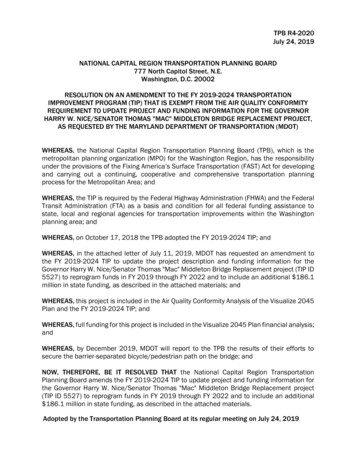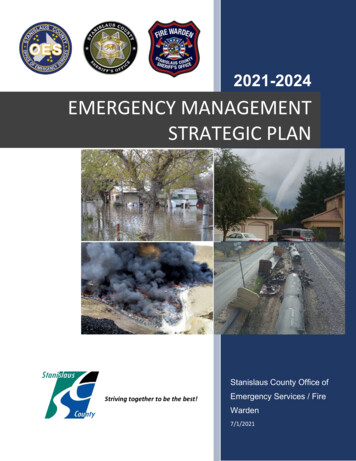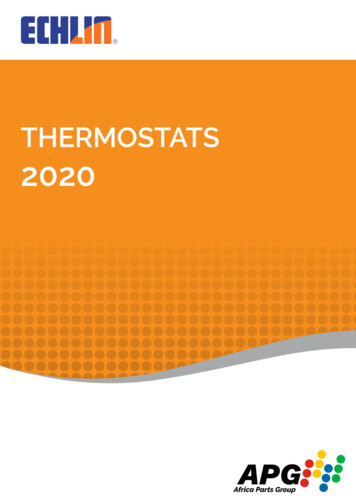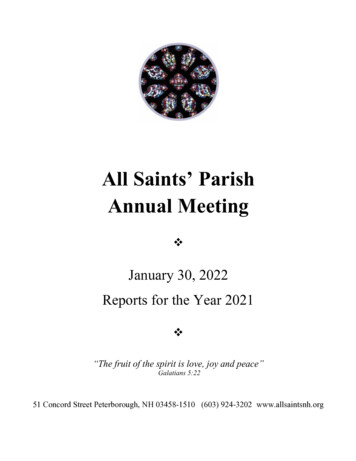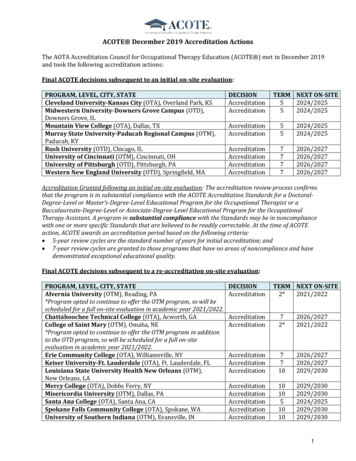
Transcription
Single Electricity Market(SEM)SEMO 2021 – 2024 Price ControlDecision PaperSEM-21-07310 September 2021
EXECUTIVE SUMMARYBackgroundA SEM Committee (SEMC) consultation (SEM-21-046) was published on 3 June 2021 on thenext SEMO price control. This outlined proposals which incorporated advance views of aParticipant Consultative Forum, representing a broad range of participants and indu strybodies. Key feedback was that SEMO should focus on stabilising existing marketarrangements as a priority while acknowledging that considerations about future marketdesign are also important. There was general agreement that evolution rather than revolutionis required in the 2021-24 period.A summary of the price control consultation proposals is as follows:SEMO bestestimates2018-21SEMO submission2021-24RAs’ consultation proposalsOpex 30.7M 44.9M 32.7MCapex 16.7M 29.3M 28.1MCapexframework-Agile & flexibleframeworkAgile & flexible framework withre-categorisation of projects enhanced reporting with marketparticipant involvementKPIs-Retain existing suitebut amend upper andlower boundsAmend existing suite but retainupper and lower bounds introduce 2 conditionsUp to 1.8MUp to 1.3M 0.8MRetain approach toWACC ( 2.2M)Retain approach to WACC 2.2M 0.9MRetain receipt ofPCG ( 0.9M)Retain receipt of PCG 0.9M 2.4MRetain margin forcollection agentactivity ( 2.4M)No margin for collection agentactivity 0n/aNew premiums forasymmetric capexrisk ( 0.8M) andopex riskNo premium for asymmetriccapex risk 0 (or opex risk)FinanceabilityTable A: Summary of 2021-24 SEMO price control consultation proposals2 Pa g e
In respect of the cost recovery framework for capex, SEMO had suggested that the onusshould be on the RAs to assess if actual expenditure was ‘Demonstrably Inefficient andWasteful’ (DIWE) and that a new premium (equating to 0.8M over three years) should beintroduced for the risk of disallowances. Further to this, SEMO proposed that a premium beintroduced for operational risks; the RAs did not agree with either proposal.During the 2018-21 SEMO price control, a margin was introduced to recognise SEMO’scollection agent activity. At the time, the SEMC noted that this would be reviewed at the next(2021-24) price control. SEMO proposed that provision of this margin should continue butno quantifiable evidence was provided to justify it. For consultation, the RAs did not allow forthe collection agent margin; this made a difference to SEMO’s revenue recovery of 2.4Mover the 2021-24 period. The RAs did, however propose to retain the existing RAB-WACCapproach to SEMO regulation, allowing for a ‘blended’ WACC using those calculated for themost recent EirGrid TSO and SONI TSO price controls (and apportioned on a 75:25 basis).In addition, allowance for provision of a Parent Company Guarantee was allowed in line withprecedent. Each of these two elements equates to recovery of 3.1M for SEMO.Summary of responsesEight responses1 were received to the consultation from: EDF Renewables EnergiaEnergy Association of Ireland Energy Storage Ireland Powerhouse Generation SEMO SSE Wind Energy IrelandThe SEMC wishes to thank all respondents for their input.During the consultation period, SEMO was the only stakeholder to request clarification onstatements made in the ‘Financeability’ chapter of the consultation on 5 July 2021. A copy ofthe RAs’ consultants’ report was provided to SEMO on 5 July 2021 and clarification toqueries was provided on 14 July 2021.SEMO’s response noted that the minimum adjustments to be made by the SEMC to the RAs'consultation proposals are:SEMO’s response w as marked as ‘confidential and commercially sensitive – not for publication’. A redactedversion of SEMO’s response w as provided and has been published alongside this decision.13 Pa g e
another 6 FTEs to be allowed (ie. a total of 11 additional FTEs to bolster the existing baseline of 59.5. This equates to an additional 1.5M on proposed allowances);additional pension costs to be incorporated into average salary per FTE (equates to an additional 0.6M on proposed allowances);IT hardware and software to be allowed in full (equates to an additional 1.3M on proposed allowances);IT outsourced managed services to be allowed in full (equates to an additional 1.7M on proposed allowances);provision for Strategic Initiatives opex costs in full (equates to an additional 1.9M on proposed allowances);provision for High Level Analysis and Design fees in full (equates to an additional 2.3M on proposed allowances);collection agent margin to be allowed (equates to an additional 2.4M on proposedallowances).SEMO also provided comment about some minor opex items and updates on costsexperienced to date for some IT expenditure. In addition, SEMO noted that while theproposed capex allowance is welcomed, the framework proposed (ie. no introduction ofguidelines for the RAs to assess ‘Demonstrably Inefficient and Wasteful Expenditure’(DIWE)/no premium in respect of asymmetric capex risk) needs to change.Other respondents focused on future-proofing market systems (while recognising the need tostabilise business-as-usual), the potential for involvement of participants in Testing, the needto expedite capital projects such as Electricity Balancing Guidelines and Clean EnergyPackage implementation; battery storage integration, improved service levels and ensuringadequate resources are in place to deal with the extent of change. All were keen onstakeholder engagement going forward.In terms of incentivisation, the RAs proposed to retain four 2 of the existing six KPIs with aKPI incentive reward of 1.3M (based on 4% of the total opex allowance) for the three yearperiod. However, it was proposed that the KPI reward would be conditional upon SEMO firstclosing out specific known issues and making certain improvements to resettlement and repricing by the end of the first year of this price control period (ie. by September 2022). TheRAs also sought feedback on the appropriateness of KPIs associated with the SEM systemsfully incorporating existing technologies (for example, battery storage and the ability to makeenergy payments directly to DSUs).2Invoicing, Re-settlement Queries, General Queries, System Availability4 Pa g e
SEMO did not disagree with the 4 KPIs (of existing 6) proposed but did not agree withrewards being conditional on two other elements. There was little support from otherrespondents for the introduction of conditions before rewards can be availed of.Other respondents provided ideas for KPIs and many were keen for the KPI aboutpublication of key information to be reinstated.The RAs and SEMC have considered all responses received when compiling this decision.In addition, the RAs engaged further with SEMO on 17 August 2021 to allow SEMO theopportunity to outline key elements of its response. This engagement was supplemented bya set of questions posed to SEMO on 17/18 August.OpexThe total Opex allowance for 2021-24 is 36.9M.This compares to a proposed allowance of 32.7M at consultation, SEMO’s request for 44.9M and SEMO’s best estimate of costs incurred for 2018-21 of 30.6M.The SEMC has decided to amend the following since consultation: An opex allowance commensurate with provision for an additional 3 FTEs 3 torecognise the need for functional testing by Market Operator staff is approved. Thestarting ‘baseline’ of internal headcount will be 67.5 for the purposes of calculatingopex allowances. This takes into consideration all internal, outsourced, third party (consultancy) and capitalised resources for SEMO.IT hardware and software allowance will increase from 1M to 1.9M (compare d toSEMO’s request for 2.3M). This is because SEMO provided stronger justification forsuch costs in its response to the price control consultation. The allowance is basedon actual costs incurred to June 2021, pro-rated for each future 12-month period. IT (outsourced) managed services allowance will increase from 0.8M to 1.7M(compared to SEMO’s request for 2.5M). This equates to allowance for 4 rather than 6 outsourced FTEs; the business case for other FTEs was inconsistent.IT Telecoms allowance (while not a ‘minimum requirement’ of SEMO) will increase from 0.1M to 0.2M (compared to SEMO’s request for 0.4M). This is becauseSEMO provided an up to date estimate of costs incurred in 2020/21 within itsresponse which the RAs used in revised calculations.‘High Level Analysis and Design Fees’ allowance will increase from a proposal ofzero (due to a weak business case in the consultation) to 1.5M. This compares toSEMO’s request for 2.3M. SEMO provided better justified information of the needfor this support in its response to the consultation. The RAs are mindful that thisAn average salary per FTE per year of 83.5K has been retained for the purposes of calculating an opexallow ance.35 Pa g e
function will provide support (in terms of both resourcing and intellectual capital) fortesting, battery storage integration and a number of other capital projects whichmarket participants would like to see expedited. Allowances for Recruitment and ‘General Admin’ will increase by 80K due to newinformation provided by SEMO in its response.Elements of SEMO’s price control submission considered in the RAs’ consultation which areunchanged in the SEMC final determination include: No additional pension costs of the EirGrid plc pension scheme will be included in thecalculation of average salary per FTE. No provision will be allowed for ‘Strategic Initiatives’ within opex, noting that SEMO isencouraged to deploy resource to cyber security within its internal headcount. Allowances for travel costs and disputes have not changed since consultation .The total Opex allowance for 2021-24 is 36.9M which equates to an annual opex allowanceof c 12.3M; this compares to SEMO’s best estimate of its ‘run-rate’ for 2020/21 as depictedin the chart below.Figure A: Comparison of Opex request/ allow anceA high-level breakdown of key operating cost categories which were analysed for thepurposes of determining an opex allowance is shown below:RAs’ consultation SEMC decision2021-24SEMO submissionLabour 19.2M 16.2M 16.9MIT & Telecoms 14.9M 9.9M 11.8MHR, corporate, facilities 6.2M 5.1M 5.2M6 Pa g e
Finance & RegulationTotal Opex 4.5M 1.5M 3.0M 44.8M 32.7M 36.9MTable B: Breakdow n of key opex categories: request and SEMC decisionCapexSEMO ‘factorised’ its original capex submission by 20% (ie. suggested a 20% reduction to itsforecast due to the uncertain/unknown nature of much of the proposed investment).However, the RAs did not apply the factorisation reduction at consultation to allow forsufficient flexibility. This approach will remain in the SEMC decision.The Capex allowances remain unchanged for market system release-related expenditureand unpredictable capex, however, the RAs and SEMC remind SEMO of the flexible natureof the unpredictable capex pot; it is at SEMO’s discretion, taking into account participantfeedback, to justify and prioritise projects as necessary.The allowance for predictable (ie. more certain/well scoped) capex has increased from 6.3M to 7.2M due to clarity provided by SEMO about its Finance System project. The totalcapex allowance increases from 28.1M to 28.9M (compared to SEMO’s request for 29.3M).2021-2024CapexSEMORAs’submission 29.3Mconsultation 28.1MAdditionalallowance 0.9M FinanceSystem[‘predictable’ pot]SEMCDecision 28.9MBreakdown:Market SystemReleases support 17.1M 17.1Mn/a 17.1MPredictable capex 11.8M 6.3M 0.9M FinanceSystem 7.2MUnpredictablecapex 0.3M 4.1Mn/a 4.1MTable C: Breakdow n of key capex categories: request and SEMC decisionCapex recovery frameworkThe framework for capex recovery has not changed since consultation.Introducing a ‘Demonstrably Inefficient and Wasteful Expenditure’ (DIWE) assessment bythe RAs as part of cost recovery review could lower the probability of disallowance by theRAs due to information asymmetry – this could have the perverse outcome of SEMO not7 Pa g e
trying to minimize costs, prematurely investing and adopting a more tolerant approach torisk.SEMO states that it faces a significant degree of asymmetry in respect of cost recovery forpredictable capex since it is impossible to keep any upside benefit from greater efficiencieswhile only being exposed to downside risk. SEMO focusses heavily on the risk of underrecovery, but DIWE was not applied to I-SEM implementation costs or to 2018-21 capex sothere is no evidence of risk of disallowance.NPV neutral revenue recoveryIn its price control submission, SEMO requested Net Present Value (NPV) adjustment, usingthe WACC, if SEMO is to bear the risk of cost recovery and RAB/WACC return until thecapital project is complete and capitalised and included on the Fixed Asset Register. Thiswas a different approach to that previously applied to SEMO’s investments pre I-SEM;however, I-SEM implementation costs were recovered on an NPV neutral basis as a ‘one off’approach to recognise the time-lag (5-6 years) between when costs were incurred andrecovered – EirGrid Group did not start to recover capital costs until I-SEM Go-Live.Steady state operations are now largely in place. Almost 60% of SEMO’s forecasted capitalexpenditure relates to biannual market system releases which take c12 -18 months tocomplete; another 25% of SEMO’s forecasted capital expenditure is viewed as ‘predictable’(ie. more certain/ well scoped) with projects having a short life-span.An estimated depreciation and RAB/WACC return are included within SEMO’s price controlallowances and applied to tariffs allowing SEMO to recover an estimated capex which isadjusted to reflect the actual depreciation and return values as part of the k factor trueing upprocess. SEMO is not expected to bear the risk of funding the full project cost of all projectsthrough to completion, thereby negating the need for a neutral NPV adjustment in this SEMOprice control.IncentivisationOpexAn ex-ante approach to setting opex allowances will continue to apply to this price controland, consistent with the approach taken in previous SEMO price control decisions, the RAsexpect to continue to incentivise SEMO’s opex via Revenue Cap (RPI-X) regulation.Within the current 2018–2021 SEMO price control an efficiency factor (X) of 0.3 is applied asa reduction to the indexation (RPI-0.3). This will continue for the 2021-24 price control.CapexAn ex-ante allowance/estimate will be set for capex.8 Pa g e
Actual costs for both predictable capex and unpredictable capex (to include ‘knownunknowns’) incurred will be subject to final out-turn (ex-post) efficiency review and adjustedin line with actual expenditure through the annual tariff process. If SEMO foreseesexceeding allowances, a submission for additional funding can be made to the RAs whichmay be subject to public consultation.The RAs’ ex-post review will assess if: 1. Expenditure has been efficiently incurred; 2. Expenditure was demonstrably necessary; 3. Expenditure was incremental to existing price controls and capable of beingrobustly validated by the RAs.For the avoidance of doubt, the onus will lie with SEMO to demonstrate that expenditure hasbeen incurred in line with the criteria above.KPIsAt consultation, the RAs had proposed to introduce two conditions for SEMO to meet inadvance of earning KPI rewards. However, based on stakeholder responses, the SEMC hasdecided not to introduce these two conditions.Instead two new KPIs4 (re. storage and ad-hoc resettlement) will be introduced and the fourexisting KPIs (re. Invoicing, Re-settlement Queries, General Queries, System Availability) willbe retained.The KPI framework is asymmetric; there is only an upside reward available for SEMO withno risk of financial loss or penalty. The incentive reward available to SEMO is 4% of the totalproposed opex allowance provided across the three-year period (which equates to 1.5M).While recognising respondents were concerned with the proposed removal of the TimelyPublication of Key Market Information KPI, the RAs consider a more appropriate approach isto consider a modification to the Trading and Settlement Code due to the limitations(regarding performance measurement) experienced during 2019/20 with this requirement4No separate KPI w ill be set for the know n issues, w hich are reported upon w eekly by SEMO. Instead the RAsstrongly urge SEMO to engage w ith market participants to ascertain those know n issues w hich should beprioritised including identification of those know n issues w hich have a high cost to rectify and low value add.Effort is required by SEMO to address (prioritise/action) these know n issues particularly as the revis ed SEM isalmost in its fourth year.9 Pa g e
within the KPI framework. We note that SEMO has licence obligations 5 to comply with theTrading and Settlement Code.FinanceabilityWith regard to SEMO’s ‘Financeability’, the SEMC outlines its decision on the following:Weighted Average Cost of Capital (WACC):No change to existing approach will be made for 2021-24; a blended WACC (using thatcalculated for the most recent EirGrid TSO and SONI TSO price controls and applied inspecified proportions of 75:25) will apply to SEMO.Parent Company Guarantee (PCG) provision:The SEMC does not propose a change to the existing approach to SEMO’s WACC or PCGat this time. An amount of 300K p.a. will be provided for.Collection agent margin:In its response, SEMO states that it manages cashflows covering the Capacity Market,Capacity Socialisation Fund and Residual Error, and faces significant exposure to cashshortfalls due to the revenue risk. The RAs remain of the view that the risks relate only tothe timing of cash flows and are not risks that amounts will be lost without subsequentrecovery.Taking previous SEMC statements in the 2018 price control decision about recovery of costsvia TSO tariffs for the working capital facility, the lack of evidence from SEMO about the riskinvolved to warrant receipt of a margin notwithstanding RA requests for information in thisregard and the lack of information on costs of having the facility in place/costs of drawingdown monies from it in the price control questionnaire by SEMO, the RAs have concernsabout the continuation of the margin as is.The SEMC has decided to ‘phase down’ the collection agent margin. Rather than continueto allow a margin equating to 0.25% of revenues during 2021-24, a collection agent marginwill be provided using the following rates:o Year 1: 0.15%o Year 2: 0.125%o Year 3: 0.1%5Condition 3 of the EirGrid Market Operator licence and Condition 15 of the SONI Market Operator licence10 P a g e
This equates to recovery of c. 1.3M over 3 years.This ‘phased down’ approach appreciates that the WACC return continues to increase to2023/24. In addition, rewards available to SEMO via KPIs in Year 3 should be easier toachieve. This is depicted in the chart below.SEMO Financeability for 2021-24 (Indexed to March 20)2.502007 SEM fullydepreciated2012/132.00 Millions'Phased 0.50WACC 011/122010/110.00KPIFigure B: SEMO financeability 2021-24Summary: Variation from consultation to decisionA summary of the SEMC’s price control decision for the SEMO price control 2021-24 is asfollows:SEMO submissionRAs’ consultationproposalsSEMC decisionOpex 44.9M 32.7M 36.9MCapex 29.3M 28.1M 28.9MRetain existing suitebut amend upperand lower boundsUp to 1.8MAmend existing suite butretain upper and lowerbounds introduce 2conditions before rewardscan be attained Up to 1.3MAmend existingsuite 2 new KPIs[no conditions]Retain approach to WACC( 2.2M)Retain approach toWACC 2.2M2021-2024KPIsFinanceability Retain approach toWACC ( 2.2M)Up to 1.5M11 P a g e
Retain receipt ofPCG ( 0.9M)Retain receipt of PCG( 0.9M)Retain receipt ofPCG 0.9MRetain margin forcollection agentactivity ( 2.4M)No margin for collectionagent activity ( 0)Margin allowed forcollection agentactivity but phaseddown c. 1.3MNew premium forasymmetric capexrisk ( 0.8M)No premium for asymmetriccapex risk ( 0)No premium forasymmetric capexrisk 0 (or opexrisk)Table D: Summary of 2021-24 SEMO price control decisions12 P a g e
Contents1.2.3.4.5.6.7.Introduction . 151.1Background. 151.2Principles and Assumptions. 161.3Developments since consultation . 171.4Format and purpose of document . 18Regulatory Framework . 192.1Summary of RAs’ proposals for consultation . 192.2Responses to consultation . 202.3RAs’ comments . 212.4SEM Committee decision. 23Operational Expenditure (OPEX) . 253.1Summary of RAs’ proposals for consultation . 253.2Responses to consultation . 263.3RAs’ comments . 293.4SEM Committee decision. 34Capital Expenditure (Capex). 374.1Summary of RAs’ proposals for consultation . 374.2Responses to consultation . 384.3RAs’ comments . 394.4SEM Committee Decision . 404.5Regulatory Asset Base (RAB), Depreciation, WACC Return . 43Incentivisation . 455.1Summary of RAs’ proposals for consultation . 455.2Responses to consultation . 465.3RAs’ comments . 485.4SEM Committee decision. 50Financeability. 526.1Summary of RAs’ consultation proposals . 526.2Responses to consultation . 536.3RAs’ comments . 546.4SEM Committee decision. 57Summary of Decision . 587.1Summary of SEM Committee decision . 5813 P a g e
8.Next Steps . 608.1Regulatory reporting and involvement of market participants going forward . 608.2Licence modifications . 608.3Future price control reviews . 60Appendix A: 2021/2024 SEMO KPIs . 6114 P a g e
1. Introduction1.1BackgroundThe next SEMO price control is due to commence on 1 October 2021 for three years until 30September 2024.During the price control review period, SEMO submitted proposals relating to operatingexpenditure (opex), capital expenditure (capex) and modifications to its existing suite of KeyPerformance Indicators (KPIs) for review by the Commission for Regulation of Utilities (CRU)in Ireland and the Utility Regulator (UR) in Northern Ireland, collectively referred to as theRegulatory Authorities (RAs). SEMO proposed amendments to the price control frameworkand approach to capital cost recovery, and sought engagement with the RAs about theintroduction of new margins in addition to its existing receipt of a WACC return, an amountfor provision of a Parent Company Guarantee and a margin on collection agent revenues.A SEM Committee (SEMC) consultation (SEM-21-0466) was published on 3 June 2021about the next SEMO price control. This outlined the RAs’ proposals which consideredadvance views of a Participant Consultative Forum (PCF). This group was established bythe RAs to gather views representing a broad range of participants and industry bodies. Keyfeedback from the PCF was that SEMO should focus on stabilising existing marketarrangements as a priority while acknowledging that considerations about future marketdesign are also important. There was general agreement that evolution rather thanrevolution is required in the 2021-24 period.A summary of the SEMC’s price control proposals which were subject to public consultationfrom 3 June – 21 July 2021 is as follows:SEMO bestestimates2018-21SEMO submission2021-24RAs’ consultation proposalsOpex 30.7M 44.9M 32.7MCapex 16.7M 29.3M 28.1M-Agile & flexibleframeworkAgile & flexible framework withCapexframework6re-categorisation of projects enhanced reporting with marketparticipant involvementSEM-21-046 SEMO 2021-24 Price Control Consultation.pdf (semcommittee.com)15 P a g e
KPIs-FinanceabilityRetain existing suitebut amend upper andlower boundsAmend existing suite but retainupper and lower bounds introduce 2 conditionsUp to 1.8MUp to 1.5M 0.8MRetain approach toWACC ( 2.2M)Retain approach to WACC 2.2M 0.9MRetain receipt ofPCG ( 0.9M)Retain receipt of PCG 0.9M 2.4MRetain margin forcollection agentactivity ( 2.4M)No margin for collection agentactivity 0n/aNew premiums forasymmetric capexrisk ( 0.8M) andopex riskNo premium for asymmetriccapex risk 0 (or opex risk)Table 1.1: Summary of 2021-24 SEMO price control consultation proposals1.2Principles and AssumptionsDurationThe duration of the next SEMO price control will be three years (1 October 2021 to 30September 2024).IndexationAll costs in this consultation are based on March 2020 prices, consistent with SEMO’ssubmission. An adjustment will be made within market operator tariffs to adjust for out -turninflation. This is carried out as part of the k-factor trueing up adjustments undertaken eachyear as part of the tariff process. The indexation rate applicable will be a blended rate of theConsumer Price Index in Ireland (75%) and the Consumer Price Index including owneroccupiers’ Housing costs (CPIH) in Northern Ireland (25%). This represents a change toindexation for Northern Ireland which previously was indexed using the Retail Price Index(RPI). The change is consistent with the indexation applied to the SONI 2020 – 2025System Operator price control.Revenue recovery apportionment16 P a g e
Consistent with previous SEMO price controls, the 2021-24 price control will be provided ona combined basis between EirGrid and SONI on a 75% and 25% basis respectively, withrevenues being ascribed to EirGrid in its capacity as market operator for Ireland and to SONIin its capacity as market operator for Northern Ireland. The current apportionment is alsodetailed in the Market Operator Agreement between EirGrid and SONI.Other assumptionsIn addition to the principles outlined above, we provide a list of other key assumptions someof which are reflected in this decision and others which will impact the k factor trueing upadjustment process. They are: Business-as-usual approach to operating and maintaining the balancing market; Changes in legislation or regulation that impose unforeseen costs to SEMO’soperations are grounds for making a submission to the RAs’ Variations in market energy demand from the level assumed in tariffs will be tr eatedon a pass through basis; Tariff revenue associated with accession or participation fees under the TSC isseparately recoverable and to continue to be declared in the annual k factoradjustment process; Foreign exchange rate assumed within SEMO’s submission and this paper is 1: 0.9 with actual foreign exchange rate gains or losses catered on a cost pass throughbasis as part of the k-factor adjustments;Interest on borrowings associated with the SEM business are catered on a cost pass through basis;Interest received on surplus funds associated with the SEM business are catered ona cost pass through basis.1.3Developments since consultationOther than price control responses, no further submissions were made by SEMO or anyother stakeholders during the consultation period.During the consultation period, SEMO requested clarification on statements made in the‘Financeability’ chapter of the consultation on 5 July 2021. A copy of the RAs’ consultants’report was provi
the RAs' consultants' report was provided to SEMO on 5 July 2021 and clarification to queries was provided on 14 July 2021. SEMO's response noted that the minimum adjustments to be made by the SEMC to the RAs' consultation proposals are: 1 SEMO's response was marked as 'confidential and commercially sensitive -not for publication .

